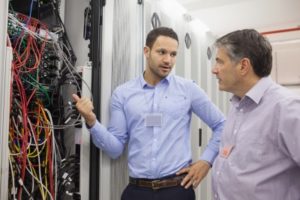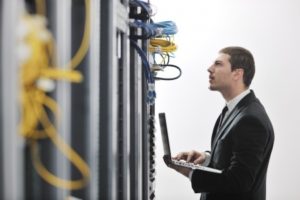Ocean waters are warming and becoming more acidic, ice caps are melting, and sea levels are rising. Warmer global temperatures affect our water supplies, agriculture, power and transportation systems, the natural environment, and even our own health and safety.
Multiple studies published in peer-reviewed scientific journals show that 97 percent or more of actively publishing climate scientists agree 1: Climate-warming trends over the past century are mostly due to human activities.
While technology has played its part in causing climate change it can also help us get to solutions. Here are five initiatives taking place in the technology community that can fight climate change:
 1. Data centers
1. Data centers
The world’s most influential companies including Apple, NIKE, IKEA, Johnson & Johnson, and Starbucks, representing over US $1 trillion in annual revenue, are committed to 100% renewable power. Much of the energy used in data centers is not from the actual technology. Instead, it’s from cooling the servers. As well as delivering on emission reduction goals, renewable power can help manage fluctuating energy costs, improve reputation and provide energy security. It also shows business leadership on climate change. This could have massive impact if paired alongside robust government policy that boosts confidence and enables long-term investments.
2. Mobile apps
It takes some digging to find apps that will help you create real change on a daily basis, but they’re out there. Here are some examples of apps that can help you monitor and reduce your carbon footprint and waste:
-
- Oroeco is an app that tracks your carbon footprint by placing a carbon value on everything you buy, eat, and do, and then shows you how you compare with your neighbors.
- PaperKarma is an easy way to cut paper waste. Take a photo of your junk mail, send it through the app, and PaperKarma will figure out what it is and take you off the mailing list.
- GiveO2 tracks your carbon footprint as you travel. Turn on the tracker when you start a new trip, and it will automatically calculate a timeline of your carbon usage. At the end, you can “offset” it by supporting a sustainable project of your choice.
 3. IoT
3. IoT
Monitoring our energy usage makes it possible to be smarter about it. Take Nest, for instance. While an un-programmed thermostat can waste 20% of heating and cooling, Nest tackles the issue with a smart thermostat that learns your patterns and automatically adjusts to save energy. The Internet of Things can save energy and carbon footprints with things as simple as using an app to turn off the lights or with apps like IFTTT, which hooks up to many different types of systems. The IoT can also involve monitoring your sprinkler system to save water, or use sensors to tell you to take a different route when driving to avoid idling in traffic and wasting gas.
4. Open source movement
Open data and open source technologies are a huge way to accelerate environmental research and innovation. Take Tesla, for example. By opening the company’s patents to everyone, Elon Musk wanted to make sure electric vehicles succeeded faster.
5. Mapping
Interactive maps really drive home the point of climate change and can lead the way to remedies. Map layers defining vegetation, soil type, geology, precipitation, and human infrastructure can help model and plan for future change. New mapping technology can make us safer and less reliant on fossil fuels. The U.S Geologic Survey’s 3D Elevation Program is being developed to use advanced mapping to better update hazard maps for floods and earthquakes and find out where the best areas for solar and wind farms.
As you can see, many of these things only require small changes from individuals in order to make a difference for our climate. Some will require much more intentional decisions from businesses. The good news, however, is that with this intentionality, individuals and corporations alike can take action to help our climate. If we’re all in this together, perhaps it’s time that we take a look – individually and corporately – at how we can make a difference.
1. J. Cook, et al, “Consensus on consensus: a synthesis of consensus estimates on human-caused global warming,” Environmental Research Letters Vol. 11 No. 4, (13 April 2016); DOI:10.1088/1748-9326/11/4/048002
Beyond The Role of Reseller and Implementer
In the past 10 years, the evolution of technology has continued to accelerate every year at a dizzying pace. It is now more challenging than ever before for IT leaders to develop and implement technology strategies for their organizations without the help of outside resources.
There are simply too many variables and solution options; and the speed with which technologies change can create confusion, delayed decision making, and, consequently, cause delays for important projects. Utilization of outside resources to assist with implementation has been at the core of services offered by Zunesis for over 12 years. But, during this time, we have also provided many of our customers formal, vendor-neutral Assessment and Strategy Development consulting services.
If you are responsible for managing IT architecture direction for your company, you have far more variables to consider than at any time before. Here are a few of the variables you need to factor into your planning:
Virtualization
- What Hypervisor will you use?
- Will you begin utilizing Converged solutions?
- Will you virtualize all workloads? How will you decide?
Storage
- What type of storage will you deploy? Locally attached, centralized/shared storage using Fibre Channel and iSCSI?
- Will you use All Flash or Hybrid?
- Will you separate storage by workload?
- Will you utilize cloud storage?
- Will you provide storage through Converged or Hyper Converged solutions?
- How will you protect your storage infrastructure?
- How do you ensure a storage infrastructure that will meet performance demands? How will that scale?
Networking
- Will you maintain a physical network infrastructure or begin utilizing some form of software defined networking solution?
- How will you provide security across your network?
Availability
- How will you provide availability for your virtualized infrastructure?
- How will you protect your data?
- Are there SLA’s that need to be met? Are these well-defined? Do you know the RPO/RTO requirements for your organization?
- Do you provide a separate protection strategy for your data and virtual machines?
Cloud
- How does Cloud fit into your strategy?
- What workloads will be appropriate in the cloud?
- How will you migrate workloads to the Cloud?
- Will cloud be part of your disaster recovery strategy?
 The questions listed above are very familiar to today’s IT leader. And, in fact, they represent only part of all that needs to be considered when developing your IT infrastructure strategies. These questions, and the path to getting them answered, is also familiar to your technical team at Zunesis. As a Solution Provider and Value Added Reseller for over 12 years, we’ve seen the industry through many transformations. And with Account Managers and Technical personnel having decades of experience, Zunesis has been involved with every aspect of IT Infrastructure design, implementation, and support.
The questions listed above are very familiar to today’s IT leader. And, in fact, they represent only part of all that needs to be considered when developing your IT infrastructure strategies. These questions, and the path to getting them answered, is also familiar to your technical team at Zunesis. As a Solution Provider and Value Added Reseller for over 12 years, we’ve seen the industry through many transformations. And with Account Managers and Technical personnel having decades of experience, Zunesis has been involved with every aspect of IT Infrastructure design, implementation, and support.
But beyond the technical expertise, Zunesis makes it our mission to be an advocate for our customer, apart from representing the manufacturer and software vendor solutions we sell. It is our level of experience and our Customer First belief that qualifies us to help our clients define their IT strategies, not just act as a reseller and implementer.
While many of the challenges faced by you as an IT leader are common, we know that you have unique requirements when it comes to how we can best help you meet those challenges. Over the years our independent consulting services have taken many forms. Here are just a few of the types of consulting services we have delivered:
- Detailed documentation of existing IT Infrastructure. This documentation is often used to begin the process of evaluating future strategy.
- Performance assessments for storage, networking, and compute. In addition to documentation of the performance data, these assessments include infrastructure documentation and recommendations for improvement if performance problems are identified.
- IT Infrastructure Assessments. These are our most comprehensive offering and help define where you are, where you want to go, and recommendations for getting there. Our assessments include:
- Infrastructure documentation
- Documentation of goals/objectives
- Stakeholder discovery sessions
- Recommendations
- Implementation Roadmaps
- Backup and Disaster Recovery planning
- Request for Proposal and Request for Quote development
- Data Classification Assessments
The services listed above don’t replace the role of an IT leader in an organization, rather, they are designed to help organize the information required for you to make better informed decisions. Bringing in an outside resource, with experience across many technologies, is your way to enhance your own process and help you successfully define and implement your IT strategies.




